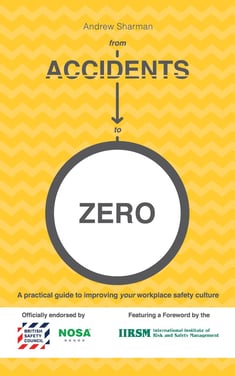From Accidents to Zero by Andrew Sharman: Summary & Ideas

From Accidents to Zero by Andrew Sharman is a concise and easy to read from A to Z manual for any safety manager or safety professional seeking to improve his or her organisation’s or customer’s safety culture. Like any function, industry or subculture, workplace safety has created its own language, vocabulary and concepts which this book quite effectively deconstructs.
Andrew Sharman is Professor of Leadership and Safety Culture at the European Centre for Executive Development (CEDEP) at Fontainebleau in France, Teacher at Caltech, sought-out speaker, best-selling author of nine books and President of the world’s largest professional health and safety membership organisation: Institution of Occupational Safety & Health (IOSH).
Three ideas to remember:
- Most of the people at your workplace are not thinking about health and safety
- Safety culture is mostly just simple behaviours and habits done regularly
- Do not aim to (just) prevent accidents, but (also) proactively create safety
Summary:
Simply Safety
Starting from Accidents and ending in Zero, the book is divided into 26 short and easy-to-consume chapters; one for each letter in the alphabet. Just as the book gives a well-framed introduction to what safety is, it also helps to clarify what it is not. Even though all subjects and topics consist of their own vocabulary and safety is not an exception here, it is nonetheless not rocket science. Many of the concepts like Leadership, Mindfulness and Trust are easy to understand even without reading any further. What Professor Sharman does well is to simplify some concepts where different organisations and legislation bodies have created unnecessary discrepancies. Accident is an event causing injury. Near miss is a no-injury event that could have caused an injury.
That’s how simple it should be because, as Professor Sharman points out, most of the people in your workplace do not actively think about safety. They ponder their own work task, their lives, their family and friends and their personal issues. I bet the author has familiarised himself well with the famous quote of Albert Einstein: “Everything should be as simple as possible, but not simpler.”
Culture is all about behaviour
Safety Culture is a topic that we hear a lot, but how often do you hear it just for the sake of it being a buzzword? I bet more often than you think. The author provides an easier way to understand safety culture by saying it’s all about behaviours. Even for employees and stakeholders who are not actively engaged in thinking safety, this is internalised swiftly. If you are doing risky behaviours, e.g. not wearing a helmet on site, you are behaving unsafely. If you as a manager are not making sure corrective actions are done, you are making the underlying investigation worthless and thus hindering safety culture.
Behaviour based safety is a popular program that gives almost 700 million google hits. In the end it also consists of exactly the same ingredients as any safety culture trying to focus on safety behaviours. What is important to remember is that it’s nearly impossible to force anyone to do something, especially in the long run. Thus, managers should think carefully about incentivising both good and bad behaviours. Just think about the question shared by the author: “is the “Wear Safety Glasses” sign ineffective because there are no glasses available or because there is no consequence for those who do not wear them?”
Professor Sharman also lists some of the most important elements of safety culture, which include the following: management commitment, risk perception and management, safety systems and procedures, work pressures and scheduling, employee training and competence, genuine and consistent management of safety, clear communication, employee engagement and involvement, responsibility and regulatory compliance. How to translate these into action is to proactively design and do those daily activities, rituals and behaviours that take these into account. A good example that Professor Sharman mentions is Daily Dialogue. It's a short three question standing meeting that the whole team participates in.
Note that how you design the three questions defines the focus. Here at Plan Brothers we use Daily Dialogues to keep up with the fast product development progress which requires clear communication and team-based problem solving. Our three questions are:
- What did you do yesterday?
- What will you do today?
- Are there any impediments in your way?
Near misses, unsafe acts and observations
Today we find it popular to talk about safety observations but it was only 90 years ago when Herbert Heinrich introduced popular triangle to show how many near misses, unsafe acts or other so called low-threshold observations happen for every accident. Avoiding the definitions of the concepts here, we’ll focus more on barriers why many organisations find it hard to get these events reported. Andrew Sharman lists the following barriers:
- Fear: especially the fear of being blamed and ridiculed by managers.
- Complexity: too difficult and tedious process of creating these reports.
- Peer pressure: making your team and peers look bad.
- Apathy: not taking action on the reported near misses.
- Bureaucracy: in any part of the process.
Remember also that safety should not see just as bad outcomes as ‘zero accidents’ goal often limits our minds to look at it. Instead, it is also about noticing peers using safety gears, praising employees for taking timely safety actions and other positive safety observations. That’s how I as a reader understood Professor Sharman’s most important point of the book: Do not aim to (just) prevent accidents, but (also) proactively create safety. When safety is managed well, it’s a feeling of trust, daily actions and behaviours and regular communication that leads towards more employees thinking about safety and in the end less and fewer accidents.
If you are interested in reading the book, check Andrew Sharman’s website or order a copy from Amazon.
This blog post is a part of the safety book summaries blog series, that also includes the following books:
- A good safety book missing? Request us to summarise it here!
Want to learn more about the subject? Download our VUCA white paper to learn more about how the operating environment is changing and why all organisations need to become more agile today rather than tomorrow:
We are building the world's first operational involvement platform. Our mission is to make the process of finding, sharing, fixing and learning from issues and observations as easy as thinking about them and as rewarding as being remembered for them.
By doing this, we are making work more meaningful for all parties involved.
More information at falcony.io.

Related posts
Accidents, causes, investigation and prevention: book summary
Accidents: causes, investigation and prevention by Doctor James Thornhill is an introductory book...
How Internal Communications Can Improve Work Environment and Safety Management
Internal communications is a fuzzy topic, especially in work environment and safety management....
Eight Plus One Books Every Safety Manager Should Read In 2022
“When you repeat a mistake, it’s not a mistake anymore. It’s a decision.”
— Paul Coelho.
Reading...






